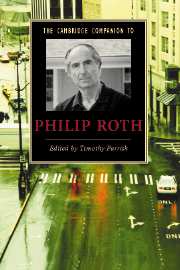Book contents
- Frontmatter
- Introduction: Roth at mid-career
- 1 American-Jewish identity in Roth’s short fiction
- 2 Roth, literary influence, and postmodernism
- 3 Zuckerman Bound: the celebrant of silence
- 4 Roth and the Holocaust
- 5 Roth and Israel
- 6 Roth’s doubles
- 7 Revisiting Roth’s psychoanalysts
- 8 Roth and gender
- 9 Roth and ethnic identity
- 10 Roth’s American Trilogy
- 11 Roth’s autobiographical writings
- Further reading
- Index
7 - Revisiting Roth’s psychoanalysts
Published online by Cambridge University Press: 28 May 2007
- Frontmatter
- Introduction: Roth at mid-career
- 1 American-Jewish identity in Roth’s short fiction
- 2 Roth, literary influence, and postmodernism
- 3 Zuckerman Bound: the celebrant of silence
- 4 Roth and the Holocaust
- 5 Roth and Israel
- 6 Roth’s doubles
- 7 Revisiting Roth’s psychoanalysts
- 8 Roth and gender
- 9 Roth and ethnic identity
- 10 Roth’s American Trilogy
- 11 Roth’s autobiographical writings
- Further reading
- Index
Summary
I write fiction and I'm told it's autobiography, I write autobiography and I'm told it's fiction, so since I'm so dim and they're so smart, let them decide what it is or it isn't.
The distinction between autobiography and fiction is always problematic, and no writer poses a greater challenge to untangling the threads of life and art than does Philip Roth, who goes out of his way to bedevil his readers. Like Nabokov, who sets traps in Lolita for psychoanalytically oriented readers who try to understand the source of Humbert's obsession, Roth both encourages and discourages public scrutiny of his life. He frequently uses real characters' names in his novels while contending at the same time that he is imagining events that never happened. Even in his memoirs, like The Facts: A Novelist's Autobiography, he creates a countervoice, his fictional alter ego Nathan Zuckerman, who insists that “Philip Roth” is lying about his life. What, then, should a reader do to find the figure behind the veil - or the ventriloquist behind his fictional voices?
I cannot answer these questions definitively, but I can make a start. While writing The Talking Cure, I began to suspect, on the basis of reading Portnoy's Complaint and My Life as a Man, that both novels dealt with Roth's own psychoanalysis. Readers familiar with Portnoy's Complaint will remember Spielvogel's celebrated punch line at the end of the novel: “So [said the doctor]. Now vee may perhaps to begin. Yes?” (274) - Roth's comic suggestion that his eponymous hero's embattled psychoanalytic odyssey is only beginning.
- Type
- Chapter
- Information
- The Cambridge Companion to Philip Roth , pp. 94 - 110Publisher: Cambridge University PressPrint publication year: 2007
- 1
- Cited by



